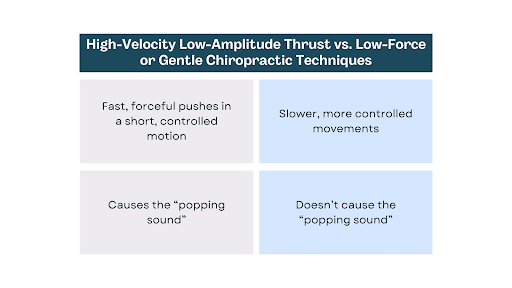Ever had an achy back or a stiff neck?
Chances are, friends and family have told you to seek chiropractic care for your discomfort.
But what exactly do chiropractors do to your back? They’re masters at a technique called spinal manipulation, which they use to help get your spine back in tip-top shape.
In this article, we’ll dive into how chiropractors work their magic on your back and why their hands are like gold for your spine!
Chiropractors give a helping hand to over 35 million of our fellow Americans every year!
What are Chiropractic Spinal Adjustments?
You know how sometimes things get out of place, like when you jam too many clothes into a drawer, and it won’t shut properly?
Sometimes, the bones in our back, called vertebrae, move out of their regular positions, causing pain, stiffness, or other health issues.
That’s where chiropractors come in!
A chiropractor is a healthcare provider trained to help get those bones back in line.
During a chiropractic spinal adjustment, the chiropractor uses their hands to apply a controlled, sudden force to a specific part of the spine. This process helps improve spinal motion, pain levels, and the body’s overall function.
Think of chiropractic care like a tune-up for your back, ensuring everything lines up just right so you can move freely and comfortably!
Chiropractors are dishing out a whopping 100 million adjustments daily across the globe!
The 2 Main Spinal Manipulation Techniques

When you hear about chiropractors, you instantly think of that one way they adjust the spine with a quick push and a pop, right?
But there’s a lot more to chiropractic care than that.
In fact, chiropractors have dozens of different techniques at their disposal to bring balance to your spine health. However, most spinal issues may be solved through two particular techniques:
- High-Velocity Low-Amplitude Thrust
- Low-Force or Gentle Chiropractic Techniques
Spinal Manipulation: High-Velocity Low-Amplitude Thrust
Let’s decode the meaning of High-Velocity Low-Amplitude Thrust or HVLA:
- High-velocity means it’s a quick movement. Think of it as a sprinter racing across a short distance.
- Low-amplitude means the movement doesn’t cover a large space. In other words, it’s a short, controlled motion.
When using HVLA, chiropractors give a specific part of the spine a quick, short push to offer pain relief. And yes, this is often the technique where you might hear that “pop” or “click” sound. Don’t worry; that’s just air bubbles in the fluid around your joints being released!
HVLA is popular among chiropractic patients and providers, covering all sorts of aches and pains, such as stiff backs, neck pain, or headaches.
Spinal Mobilization: Low-Force or Gentle Chiropractic Techniques
Think of spinal mobilization as the gentler cousin of HVLA.
Instead of fast, forceful pushes, this method uses slower, more controlled movements to help adjust the spine. It’s akin to stretching slowly versus doing a rapid jumping jack.
Some folks deal with conditions that make the gentler touch of spinal mobilization a better fit.
Maybe their body is more sensitive, or they feel more relaxed knowing the movements will be easy and smooth. Plus, for those who aren’t fans of the “pop” sound from some other techniques, this method rarely produces that noise.
Now, how does it work? Chiropractors will use their hands or tools to apply a steady, gentle force to a specific part of the spine. This approach helps shift the bones back into a better position, relieving tension and tightness. The goal is to get things moving better without the need for any forceful adjustments.
Conditions Addressed Through Spinal Manipulation Therapy
One of the big reasons people head to a chiropractor for spinal manipulation therapy (SMT) is low back pain.
Maybe you’ve picked up something heavy the wrong way or been sitting too long in a not-so-comfy chair, and bam! Your lower back is giving you a hard time. SMT adjusts the spine in the lower back area, aiming to relieve your discomfort.
Chronic neck pain is another target for spinal manipulation.
You know how sometimes you wake up, and it feels like you’ve slept all twisted up? Or maybe after a long day of looking down at your phone or computer, your neck is screaming, “Give me a break!”
Fortunately, SMT can come to the rescue for that, too! It relieves all that pent-up pain and tightness by adjusting the upper spine, right in the neck area.
SMT also addresses other health issues outside of low back pain and neck pain. Some patients find it helps with headaches, while others notice improvements in shoulder or even knee pain.
What are the Benefits of Spinal Manipulation Therapy?
Besides pain relief, some patients find that their range of motion improves after SMT. This means they can move more freely and easily, like being able to turn their head further to check for traffic or reaching up to a high shelf.
Patients also report that SMT helps them feel more relaxed. It’s like the tension melts away from their muscles!
Another cool thing? SMT might even help with headaches! Patients who constantly deal with tension headaches or headaches that start in the neck find relief after a chiropractic session.
Is Spinal Manipulation Safe?
Based on a 2017 review covering 250 scientific studies, it’s common for patients to feel a bit of pain or discomfort, stiffness, or even a headache after chiropractic adjustments.
Fortunately, these mild side effects are rarely intense and tend to disappear within a day. It’s like when you get a little sore after trying a new exercise but feel better after resting up.
There have been reports about more serious side effects of chiropractic adjustments, including spinal and nerve issues. However, they are infrequent. You have the same chance of a severe side effect as someone getting struck by lightning while walking their dog.
And, just to be clear, researchers don’t have a solid number on how often these rare side effects occur.
Is Spinal Manipulation for Everyone?
Are spinal manipulations a one-size-fits-all kind of deal? Not really.
Chiropractors and other healthcare professionals alike use chiropractic manipulation therapy for pain management, especially in the back and neck. But, just like not everyone wears the same size shoes, chiropractic care isn’t a perfect fit for everyone.
Some people deal with conditions incompatible with spinal manipulation. For instance, if someone has a history of spinal surgery, these adjustments might not be the best approach.
How Do Chiropractors Perform Spinal Manipulation Therapy?

A chat between you and your chiropractor will kickstart your spinal manipulation treatment. They’ll ask questions about the source of your pain, how long it’s been hurting, and recent activities or accidents. Every answer will help your chiropractor figure out the best treatment plan for you.
Next, the chiropractor will have you lie on a table designed to make the spinal manipulation process smoother and more comfortable. Depending on where the pain is, you will lie face down, face up, or even on your side.
Now comes the main event: chiropractic manipulation. Using their hands, the chiropractor will feel around the spine to find any spots that feel “off” or “stuck.” Once they’ve pinpointed these tricky spots, they’ll use their hands to apply a quick, controlled push to the area. This isn’t a random push; it’s very targeted to help improve the movement in that part of the spine.
Sometimes, during this process, there might be a popping sound. It might be surprising, but it’s totally normal. That sound is just air bubbles in the joints being released, which many patients find satisfying.
After the SMT, the patient might feel instant relief or take a few sessions to notice a difference. Everyone’s body is unique, and so is everyone’s experience with spinal manipulation.
Can I Perform Spinal Adjustments on Myself?
Patients should not perform spinal adjustments on themselves, and here’s why.
Chiropractors undergo years of intense training to understand the complex structure of the spine and how to safely adjust it.
Think of them like expert mechanics for the body. Just like you wouldn’t try to fix a complicated engine problem in your car without the proper knowledge, you wouldn’t adjust your spine without the appropriate training.
When you feel that urge to crack or pop your neck or back, it might feel good momentarily, but you’re not actually addressing the root of the problem. In fact, you could be making things worse or even causing harm!
Adjusting the spine isn’t just about making a popping sound. It’s about targeting specific joints and using the proper techniques to improve movement and reduce pain.

Regain Your Spine Health With the Help of Dr. Doerr!
At Bergen Chiropractic and Sports Rehabilitation Center, our chiropractic team, under the leadership of Dr. Gregory Doerr, adheres to the highest medical standards to provide superior chiropractic help. Our mission is to provide unparalleled patient care in a comfortable, healing atmosphere.
Access our contact form or call us at (201) 945-4075 to learn more about our chiropractic care services! Our offices at 532 Anderson Avenue, Cliffside Park, NJ 07010, and 62 Summit Ave, Hackensack, NJ 07601, are ready to welcome you as we proudly serve the areas of New York, New Jersey, Philadelphia, PA, and Baltimore, MD. Also, access our blog, Facebook, and Instagram pages for more information on chiropractic treatment for back and neck pain!
References
- “Adverse Effects of Spinal Manipulation: A Systematic Review.” Journal of the Royal Society of Medicine, U.S. National Library of Medicine, July 2007, www.ncbi.nlm.nih.gov/pmc/articles/PMC1905885/. Accessed 18 Sep. 2023.
- “Chiropractic Adjustment Care, Treatment & Benefits.” Cleveland Clinic, my.clevelandclinic.org/health/treatments/21033-chiropractic-adjustment. Accessed 18 Sept. 2023.
- English, Cynthia. “One in Four Adults Sought Care for Neck/Back Pain Last Year.” Gallup.Com, Gallup, 5 Mar. 2023, news.gallup.com/poll/194984/one-four-adults-sought-care-neck-back-pain-last-year.aspx?g_source=Well-Being&g_medium=newsfeed&g_campaign=tiles. Accessed 18 Sep. 2023.
- Morris, Rebecca. “What Is Spinal Manipulation?” Healthline, Healthline Media, 15 Mar. 2016, www.healthline.com/health/back-pain/spinal-manipulation. Accessed 18 Sept. 2023.
- Sarah Jividen, RN. “Everything You Need to Know About Spinal Manipulation.” Verywell Health, Verywell Health, 8 Feb. 2022, www.verywellhealth.com/spinal-manipulation-5213994. Accessed 18 Sept. 2023.
- “Spinal Manipulation.” Physiopedia, www.physio-pedia.com/Spinal_Manipulation. Accessed 18 Sept. 2023.
- “Spinal Manipulation: What You Need To Know.” National Center for Complementary and Integrative Health, U.S. Department of Health and Human Services, www.nccih.nih.gov/health/spinal-manipulation-what-you-need-to-know. Accessed 18 Sept. 2023.
- Steven Yeomans, DC. “Understanding Spinal Manipulation.” Spine, www.spine-health.com/treatment/chiropractic/understanding-spinal-manipulation. Accessed 18 Sept. 2023.
- Zauderer, Steven. “47 Chiropractic Statistics, Facts & Demographics.” Life-Changing ABA Therapy – Cross River Therapy, Cross River Therapy, 23 July 2023, www.crossrivertherapy.com/research/chiropractic-statistics. Accessed 18 Sept. 2023.








